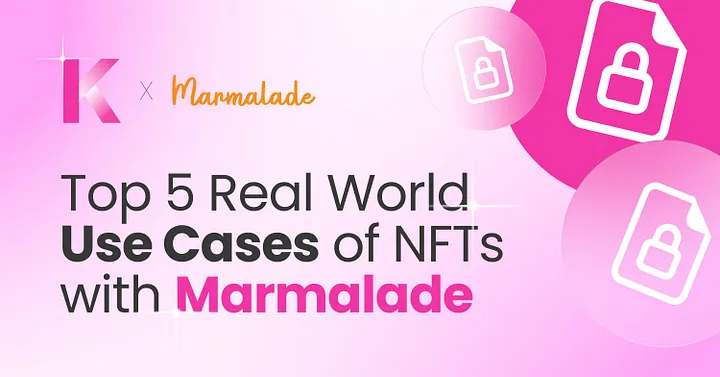Top 5 Real World Use Cases of NFTs: Redefining Ownership and Empowering Creators with Marmalade
In recent years, Non-Fungible Tokens (NFTs) have taken the world by storm, captivating both the art world and the digital landscape. These unique digital assets, built on blockchain technology, present new opportunities for ownership, authenticity, and monetization. While NFTs have garnered attention for their record-breaking sales and speculative frenzy, their true value lies in their potential to reshape industries, empower creators, and foster innovative artistic expression. In this article, we will explore practical use cases of NFTs, examine their transformative impact across different sectors, and discuss how Marmalade can make this transformation possible.
Fractionalizing Investments
NFTs have revolutionized investing by introducing fractionalized ownership. In real estate sectors, NFTs allow investors to purchase fractional shares of properties, allowing for portfolio diversification with lower capital requirements. By tokenizing real estate assets into digital tokens, NFTs democratize access to lucrative real estate investments and offer increased liquidity. Investors can buy and sell their fractional shares more easily on blockchain-based platforms.
Another example of fractionalized NFTs is the Kadena Mining Club (KMC), a grantee of Kadena. KMC gives investors the chance to mine KDA tokens without the hassles of purchasing miners and creating mining set-ups. This innovative approach not only expands investment possibilities, but also ensures transparency and security through the use of blockchain technology. It brings a substantial level of convenience and accessibility.
Gaming NFTs
Game interoperability refers to the seamless movement of assets and data between different games or platforms. NFTs enable players to potentially transfer their virtual items across various games, bridging gaps between disparate gaming worlds. This interoperability enhances player experiences and creates new opportunities for developers and players alike.
Monetization is another crucial aspect of gaming NFTs. Gamers own their in-game assets by leveraging NFTs. They also have the ability to trade, sell, or auction them on open marketplaces. This introduces the concept of true digital ownership and allows players to derive real-world value from their virtual possessions. Developers can explore new revenue models by incorporating NFTs and benefiting from in-game transactions through a royalty system.
Authentication and Identification
NFTs can function as a digital fingerprint or seal of approval for the luxury product, providing verification of its origin, provenance, and ownership history. This solution is made possible through the integration of phygital NFTs with real-world goods. By attaching NFTs to physical products, companies can establish a digital identity that enables traceability back to the source. This enhances credibility and adds value to industries like luxury goods and pharmaceuticals, where counterfeiting has been a significant concern.
Throughout the lifecycle of an item, subsequent transactions or changes in ownership can be recorded on the blockchain, creating a comprehensive and immutable chain of custody. As an example, in a recent auction, Sotheby’s sold a Schullin Wien 49ct Paraiba Tourmaline ring with its provenance verified by Kadena grantee, Database of Native Assets (DNA), and permanently stored on the Kadena blockchain.
Supply Chain Tracking and Trade Finance
Businesses often lack knowledge about important touch points within their supply chain, which can hinder their ability to optimize operations. Real-time tracking facilitated by NFTs brings additional advantages, particularly in trade finance. Financial institutions can leverage the real-time traceability of goods to accurately monitor their progress, minimizing risk and streamlining financing processes.
Kadena grantee, Database of Native Assets (DNA), recently worked with Arqit and Imperial College in creating the world’s first quantum-secure transaction between the governments of UK & Singapore. The shipment was tracked in real-time using IoT devices, and minted onto an NFT on Kadena’s blockchain.
NFTs are the Future with Marmalade, powered by Kadena
The real-world applications of NFTs have proven to be diverse and impactful across industries, spanning art, gaming, music, and supply chain. NFTs have introduced new possibilities for ownership, authenticity, and value creation. Inside this evolving landscape, Marmalade emerges as the most innovative NFT standard in the industry.
Marmalade provides a comprehensive suite of tools that offers artists, creators, users, builders, and marketplaces the means to unleash their creativity, connect with a global community, and fully unlock the potential of their digital assets. As the NFT ecosystem continues to expand, Marmalade stands at the forefront, driving innovation, fostering trust, and shaping the future of NFTs as a powerful and transformative technology.
If you’re interested in learning more about Marmalade, follow us on Twitter and join our Discord today.

